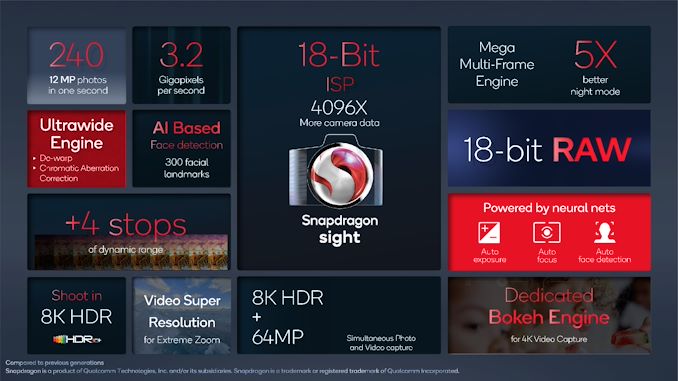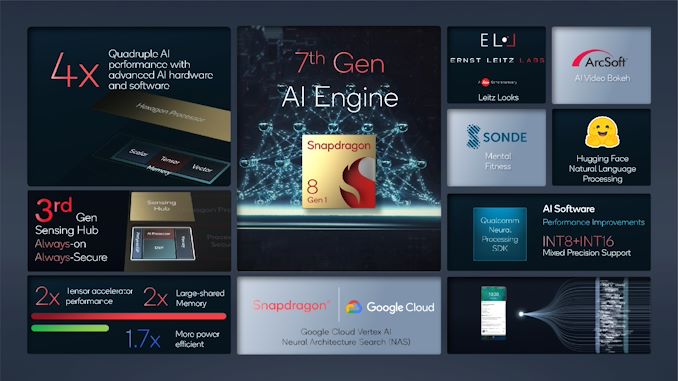Qualcomm Announces Snapdragon 8 Gen 1: Flagship SoC for 2022 Devices
by Andrei Frumusanu on November 30, 2021 6:00 PM ESTMassive ISP Upgrades
I’ve been hearing for some time now that 2022 flagships will have massive camera upgrades, and the new features of the next-gen SoCs being described by MediaTek and now also Qualcomm explain why that is.
The new ISP of the Snapdragon 8 Gen 1 falls under a new marketing name – “Snapdragon Sight”, and includes large improvements of the capabilities of the IP blocks within the image processing chain.
The big flagship feature being advertised is the fact that the new ISP is now capable of 18-bits of color depth per channel, up from the previous generation 14-bit ISP. While mobile image sensors nowadays still are barely 12-bit native in terms of their ADCs, the ushering of new HDR techniques such as staggered HDR capture, where exposures are immediately subsequent to each other on the sensor’s readout, means that new phones now are able to capture images a lot faster, recombining them into higher bit-depth results. Particularly here, the new 18-bit ISP pipeline now allows for three exposure HDR stacking off these new sensors.
The increased bit-depth should allow for an increase of 4 stops in dynamic range (or 2^4 = 16x the range), which greatly helps with very contrasting environments and challenging lighting situations. This is quite beyond any other camera solution right now, and being able to have this implemented in such a hardware fashion sort of blurs the line between traditional image capture techniques and the more software-defined computational photography methods of the last few years.
Indeed, the new ISP architecture seems to be very much a way to implement many of the existing computational photography techniques into fixed-function blocks: there’s a new neural-net controlled 3AA (auto-exposure, auto-focus, auto-white-balance) and face detection block, which sounds eerily similar to Google’s HDRnet implementations.
Night mode is also said to be vastly improved through a new multi-frame noise reduction and image stacking block, being able to now stack and align up to 30 images, and achieve also much finer detail this generation. Qualcomm here claims up to 5x better night mode shots.
Further improvements include a new distortion correction block that’s able to now also correct for chromatic aberrations, and a hardware video Bokeh engine, being able to operate at up to 4K video recording. Think of it as the same as the new Cinematic mode on the new A15 iPhones, but not only limited to 1080p.
Qualcomm notes that all the AI/ML/neural network features on the ISP are actually run and accelerated on the ISP itself, meaning that it is not offloaded onto the Hexagon dedicated ML processing blocks or the GPU.
Just as a note- Qualcomm’s 3.2Gigapixel/s throughput metric here seems low compared to the Dimensity 9000’s 9Gpixel/s, it’s possible that the companies are advertising very different metrics, with MediaTek advertising the throughput of lower-bit depth pixels coming from the image sensors per frame, while Qualcomm quoting the full bit depth pixel processing within the ISP itself.
In terms of video encoders and decoders, the new chip allows for 8K HDR recording now, but otherwise is seemingly on par with the Snapdragon 888 media blocks. Unfortunately, this also means no AV1 decoding this year yet again. Qualcomm isn’t part of the Alliance for Open Media consortium and instead is backing VVC/H.266 and EVC, however with AV1 being actively pushed by Google and YouTube, and seeing large adoptions such as by Netflix, it’s becoming questionable for Qualcomm to still not support the format in 2022 devices.
AI Performance - Iterative, but solid
Last year’s Hexagon IP block was a very large change for the Snapdragon 888. At the time, Qualcomm moved on from a more segregated DSP/AI architecture to a single more fused-together block being able to operate on scalar, vector, and tensor operations at the same time. This year’s iteration is an improvement of that larger change. Qualcomm notes that amongst many changes, they’ve doubled up on the shared memory of the block, allowing for greater performance for larger ML models (which are growing at a very fast pace).
Qualcomm didn’t note any TOPS figures this time around, instead stating we’re seeing 2x the tensor throughput performance, and smaller increases for scalar and vector processing. They do quote a day-1 to day-1 performance increase of 4x when compared to the Snapdragon 888, via a combination of both hardware and software improvements, but of course that figure is smaller when comparing both platforms on an equal software footing.
Power efficiency for AI workloads is said to be 70% better this generation, which is actually more significant, and should help with more demanding sustained ML workloads.
X65 Modem Integrated
In terms of connectivity, the Snapdragon 8 Gen 1 is quite straightforward, as it integrates the X65 modem IP that Qualcomm had already announced as a discrete model earlier this year.
The improvements here are the fact that it’s a 3GPP Release 16 compatible modem, including new features such as uplink carrier aggregation. Other improvements are 300MHz of Sub-6 bandwidth on 3 100MHz carriers, and an increase of the mmWave bandwidth from 800 MHz to 1000MHz, allowing a new peak theoretical downlink speeds of 10Gbps.












219 Comments
View All Comments
vladx - Thursday, December 2, 2021 - link
Hardware supporting VVC hardware decode has already been announced while AV2 is still hasn't even been drafted:https://www.xda-developers.com/mediateks-pentonic-...
Just because you're ignorant about the current situation, doesn't mean everyone else is as well. At this rate, consumer hardware supporting encode will be released for VVC before AV1 let alone AV2.
vlad42 - Thursday, December 2, 2021 - link
And yet there has been no coverage. So right now, consumers are far more likely to know about AV1 and demand it than an unheard of VVC.Also, do you really think any company wants to pay VVC's license fees? The problems with licensing and royalties for HEVC is why it has taken so long for it to gain any adoption whatsoever. As of right now, there are at least two different groups selling the licenses needed for the patents - this is the same situation that caused HEVC to take 5 years before it was used by anyone in volume - remember HECV was released in 2013. H.264 had only one group you needed to by a license from and the total cost of the license was lower than HEVC's. The whole point of AV1 is that it is royalty free and does not have these problems.
As for you link, there is no indication of the setting used by AV1 or VVC. However, from what is known about AV1 it is clear they used it in fixed QP mode instead of VBR mode. It is well known that AV1 is optimized for VBR and that fixed QP is inefficient (it looses out to HEVC in all but UHD). However, with VBR it out performs HEVC in terms of bit rate savings by 20% at UHD. We would need proper thorough tests to be conducted to know if VVC's fees and performance costs would be worth it compared to AV1 (not to mention that AV1 could be further improved much like HEVC was during it's lifetime and VVC undoubtedly will be).
Just because you're ignorant about the current situation, doesn't mean everyone else is as well. Hardware AV1 encoders were announced back in 2019.
On 18 April 2019, Allegro DVT announced the AL-E210 with hardware AV1 encoding support for main 0 at 4K30 at 10-bit. In addition the Allegro AL-E195 has hardware AV1 encoding support for main 0 and professional 1 and Chips&Media's WAVE627 has hardware AV1 encoding support for main 0 at up to 4K120.
Just because your going to act like a know-it-all jackass does not mean you actually know anything at all.
vladx - Thursday, December 2, 2021 - link
"Also, do you really think any company wants to pay VVC's license fees?"Umm yes? The cost savings from lower bandwidth usage provided by VVC's superior compression beats any royalties. No one besides Google and cheapskates like Mozilla minds paying royalties for the best codec around.
vlad42 - Friday, December 3, 2021 - link
If this were the case, then there would have been rapid adoption of HEVC across the board - especially among the likes of Twitch, YouTube, Netflix, Amazon Prime, etc. Instead we find that Twitch relies solely upon h.264, YouTube re-encodes as much as possible (everything?) to VP9 and h.254, and Netfix and Amazon Prime use h.264 for everything except UHD, etc.The licensing/royalty fiasco for HEVC is the largest reason why HEVC adoption has be pathetic compared to h.264. So yes, if VVC's licensing fees are anything like HEVC's, then these companies will not care about superior compression, AV1 with VBR will be good enough. It is not just Google and "cheapskates" like Mozilla.
vlad42 - Friday, December 3, 2021 - link
Damn lack of an edit button...that should be VP9 and h.264 not h.254vladx - Friday, December 3, 2021 - link
Both Netflix and Amazon Prime have been using HEVC for ages, Twitch uses H.264 because they want as many streamers as possible and there are still plenty with pre-2015 PCs who try their hand at streaming on their shitty computers.vlad42 - Monday, December 6, 2021 - link
And as I said only for 4K content. If it was really worthwhile, they would use it for everything. However they do not.Also, if Twitch wants to maximize their user base, then why go straight to AV1 and not go to HEVC? Surely more viewers have hardware decode/encode support for HEVC than AV1? The only logical explanation is that their are licensing problems/the fees are too high.
mode_13h - Saturday, December 4, 2021 - link
> Instead we find that Twitch relies solely upon h.264It seems to me that Twitch would use whatever is the lowest common denominator of its users, both in terms of their decoding & encoding capabilities. And when encoding, not only the capability matters but also how much overhead it adds, which could potentially impact gameplay.
vlad42 - Monday, December 6, 2021 - link
If Twitch wants to maximize their user base, then why go straight to AV1 and not go to HEVC? Surely more viewers have hardware decode/encode support for HEVC than AV1? The only logical explanation is that their are licensing problems/the fees are too high.name99 - Thursday, December 2, 2021 - link
In what sense are these IP blocks "consumer hardware"?I'd say a reasonable proxy for consumer hardware is "is present in some phones". Can that be said for AV1?
You can compare the uptake for AV1 with HEVC. I'd say there's a notable difference...
Especially important is HW encoders. Decoders are easy, but you need encoders in phones to get a real change in usage.
https://en.wikipedia.org/wiki/AV1#Adoption
https://en.wikipedia.org/wiki/High_Efficiency_Vide...